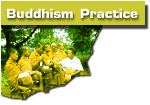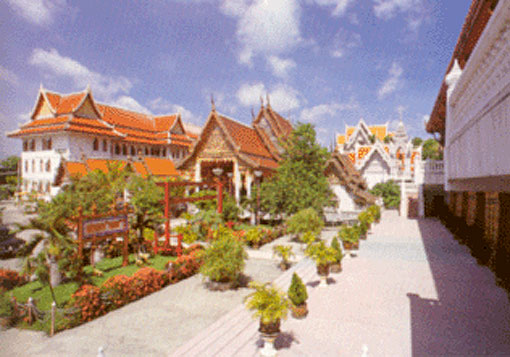 |
BANGKOK
|
||||||||
CENTRAL
|
||||||||||||
NORTHEASTERN
|
||||||||||||||
NORTHERN
|
||||||||||||
SOUTHERN
|
||||
 |
| A GUIDE TO MEDITATION CENTRES IN THAILAND |
| BANGKOK - WAT PAK NAM |
|
MEANING
OF NAME : |
"Monastery at the mouth of the river" |
ADDRESS
: |
Therdthai Rd., Amper Phasicharoen, Bangkok 10160 |
DIRECTIONS
: |
Located west across the Chao Phraya River in Thonburi, part of metropolitan Bangkok. Easily reached by city buses #4, 9, or 103. If you don't mind some spray (the water isn't too clean), you can take a long-tailed boat to the wat from Rajinee (Rachini) and Saphan Phut jetties north of the Memorial Bridge on the east side of the Chao Phraya. |
TELEPHONE
: |
0-2467-0811 |
MEDITATION
SYSTEM : |
The technique begins by concentrating on a point inside the body in the center of the abdomen, 2 finger-widths above the navel. This point is said to be the place where consciousness has its seat. The words "Samma Araham" can be repeated mentally to aid initial development of concentration. Aluminous nucleus appears at the center point, then develops into a still and translucent sphere about 2 cm in diameter. Within the sphere appears another nucleus which emerges into a sphere. The process continues with increasingly refined spheres or forms appearing in succession. The high levels of concentration achieved are used in vipassana to develop penetrating insight. A qualified teacher is important in this practice. The late abbot Ven. Chao Khun Mongkol-Thepmuni (1884-1959) popularized this meditation system. The wat has a book in English, "Samma Samadhi" by T. Magness, that explains the technique in detail. |
TEACHING
METHOD : |
Individual interviews as needed. Talks in Thai by a monk or a tape recording of Ven. Chao Khun Mongkol- Thepmuni are given 2 or 3 times a day at group sittings in the meditation hall. |
TEACHERS
: |
Chao
Khun Bhawana Kosol Thera (Thai; age 72); he speaks English and Japanese. Ven. P.K. Bhavananuwat (Thai; age 77); he speaks a littleEnglish. |
LANGUAGE
: |
Teachers speak some English and people are usually around who can translate. Easiest for one who can speak Thai. |
DESCRIPTION
: |
The
"bot" and many large, multi-story buildings are tightly
packed on the 17-rai (7-acre) grounds. Urban setting. Large crowds
of worshippers come on weekends and Buddhist holidays. The wat dates back to the early 18th century in the Ayuthaya Period. |
SIZE
: |
monks
200-400 (one of the largest populations in Thailand during the Rains Retreat) novices 80-90 nuns 200-300 laypeople about 100 (half practice meditation) |
DAILY
ROUTINE : |
Meditators can practice individually or attend group sessions. |
FOOD
: |
Good quality and variety; offered in the temple at daybreak and at 11 a.m. Monks and novices can go on pindabat if they wish. Laypeople eat after monks and novices. |
ACCOMMODATIONS
: |
Monks and novices usually stay in individual rooms, some with attached Thai- or western-style bathrooms. Nuns have shared rooms. Laypeople may be able to stay except during the Rains Retreat. |
WRITE
IN ADVANCE? : |
Not necessary. |
OTHER
INFORMATION : |
Ven.
Chao Khun Mongkol-Thepmuni revived this system of meditation, sometimes
called "Dhammakaya. " He's very highly venerated by theThais. A shrine room in the wat contains hiscoffin and a life-like wax statue. Laypeople practicing meditation normally follow 8 precepts and wear white clothing; visitors staying a week or two can follow 5 precepts and wear regular clothing. |
| Select here : |
|
|
